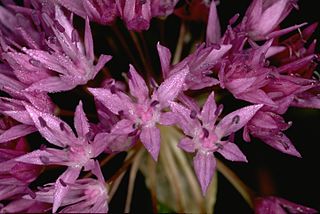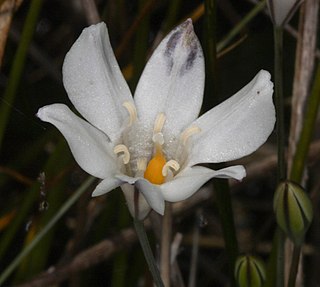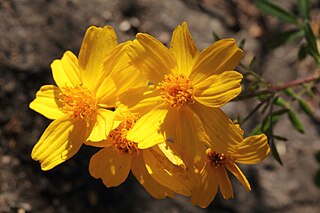
Brodiaea, also known by the common name cluster-lilies, is a monocot genus of flowering plants.

Triteleia is a genus of monocotyledon flowering plants also known as triplet lilies. The 16 species are native to western North America, from British Columbia south to California and east to Wyoming and Arizona, with one species in northwestern Mexico. However they are most common in California. They are perennial plants growing from a fibrous corm, roughly spherical in shape. They get their name from the fact that all parts of their flowers come in threes.

Brodiaeoideae are a monocot subfamily of flowering plants in the family Asparagaceae, order Asparagales. They have been treated as a separate family, Themidaceae. They are native to Central America and western North America, from British Columbia to Guatemala. The name of the subfamily is based on the type genus Brodiaea.

Triteleia laxa is a triplet lily known by several common names, including Ithuriel's spear, common triteleia and grassnut. It is native to California where it is a common wildflower, and it is occasionally found in southwestern Oregon. It bears a tall, naked stem topped with a spray of smaller stalks, each ending in a purple or blue flower. The flower is tubular, opening into a sharply six-pointed star. The plant grows from a corm which is edible and similar in taste and use as the potato. The most used common name for the species, Ithuriel's spear, is a reference to the angel Ithuriel from Milton's Paradise Lost.

Allium lemmonii is a species of wild onion known by the common name Lemmon's onion, named for botanist John Gill Lemmon (1831–1908). It is native to the western United States, at elevations of 1200–1900 m in the Great Basin of Utah, Nevada, northern and eastern California, eastern Oregon, southwestern Idaho.

Triteleia ixioides, known as prettyface or golden star, is a monocotyledon flowering plant in the genus Triteleia. It is native to northern and central California and southwestern Oregon, where it can be found in coastal and inland coniferous forests and other habitat. It is a perennial wildflower growing from a corm. It produces one to two basal leaves up to 50 centimeters long by 1.5 wide. The inflorescence arises on an erect stem up to 80 centimeters tall. It is an umbel-like cluster of several flowers each borne on a pedicel up to 7 centimeters long. The flowers are variable in size, measuring one to nearly three centimeters in length. They are pale to bright yellow, or sometimes purple-tinged white. There are six tepals with darker midveins in shades of green, brown, or purple. The lobes are funnel-shaped and may open flat or somewhat reflexed. The six stamens form a fused tube that protrudes from the corolla; they have broad, flat filaments and whitish, yellowish, or blue anthers.

Triteleia crocea, with the common names yellow triteleia and yellow tripletlily, is a monocot flowering plant in the genus Triteleia.

Prunus fremontii is a North American species of plants in the rose family, known by the common name desert apricot. It takes its scientific name from John C. Frémont. It is found in northern and western Baja California especially, mostly Pacific and western, and the adjacent area of southern California. It also occurs in northern Baja California Sur.

Quercus arizonica, the Arizona white oak, is a North American tree species in the beech family. It is found in Arizona, New Mexico, western Texas, Sonora, Chihuahua, Coahuila, Sinaloa, and Durango.

Triteleia clementina is a rare species of flowering plant known by the common name San Clemente Island triteleia. It is endemic to San Clemente Island, one of the Channel Islands of California, where it is known from about twenty occurrences. Its habitat includes moist, rocky, seaside grassland. It is a perennial herb growing from a corm. It produces two or three keeled, lance-shaped leaves up to 100 centimeters long by three wide. The inflorescence arises on an erect stem up to 90 centimeters tall and bears an umbel-like cluster of many flowers. Each flower is a funnel-shaped lavender or light blue bloom with six lobes measuring up to 1.5 centimeters long. There are six stamens with purple anthers.

Triteleia dudleyi is a species of flowering plant known by the common name Dudley's triteleia. It is endemic to California, where it is known from sections of the High Sierra Nevada and the Transverse Ranges. It is a plant of subalpine climates, growing in mountain forests. It is a perennial herb growing from a corm. It produces two or three basal leaves up to 30 centimeters long by one wide. The inflorescence arises on an erect stem up to 30 or 35 centimeters tall and bears an umbel-like cluster of many flowers. Each flower is a funnel-shaped yellow bloom that dries purple. The flower has six lobes measuring up to 1.2 centimeters long. There are six stamens with lavender anthers.

Triteleia grandiflora is a species of flowering plant known by the common names largeflower triteleia, largeflower tripletlily, and wild hyacinth. It is native to western North America from British Columbia to extreme northern California, eastward into Idaho, Montana and northern Utah, with disjunct populations occurring in Wyoming and Colorado. Its habitat includes grassland, sagebrush, woodlands, and forests. It is a perennial herb growing from a corm. It produces two or three basal leaves up to 70 centimetres (28 in) long by 1 cm wide. The inflorescence arises on a smooth, erect stem up to 75 cm (30 in) tall and bears an umbel-like cluster of many flowers. Each flower is a funnel-shaped bloom borne on a pedicel up to 4 or 5 cm long. The flower may be up to 3.5 cm long including the tubular throat and six tepals each just over 1 cm long. The inner set of three tepals are somewhat ruffled and broader than the outer tepals. The flower corolla may be deep blue to almost white with a darker blue mid-vein. There are six stamens with purple or yellow anthers.

Triteleia hyacinthina is a species of flowering plant known by the common names white brodiaea, white tripletlily, hyacinth brodiaea, and fool's onion. It is native to western North America from British Columbia to Idaho to central California. Its habitat includes grassland and vernally moist areas such as meadows and vernal pools. It is a perennial herb growing from a corm. It produces two or three basal leaves up to 40 centimeters (16 in) long by 2 centimeters (0.79 in) wide. The inflorescence arises on an erect stem up to 60 centimeters (24 in) tall and bears an umbel-like cluster of many flowers. Each flower is a funnel-shaped bloom borne on a pedicel up to 5 centimeters (2.0 in) long. The flower is white, often tinged purple along the tubular throat, with six green-veined tepals. There are six stamens with white, yellow, or occasionally blue anthers.

Triteleia montana is a monocot flowering plant in the genus Triteleia. Its common names include Sierra triteleia, and mountain triteleia. It is endemic to California, where it is limited to the Sierra Nevada. It occurs in coniferous forests on granite soils. The Latin specific epithet montana refers to mountains or coming from mountains. It is a perennial wildflower growing from a corm. There are two or three basal leaves measuring up to 30 centimeters long and just a few millimeters wide. The inflorescence arises on an erect, rough-haired stem up to 25 or 30 centimeters tall. It is an umbel-like cluster of several flowers each borne on a pedicel up to 3 centimeters long. The flower is yellow with a dark midvein, and dries purplish. The funnel-shaped corolla is made up of six tepals up to a centimeter long each. There are six stamens with white or blue anthers.

Triteleia peduncularis is a monocot flowering plant in the genus Triteleia. Its common names include long-ray brodiaea and longray triteleia. It is endemic to California, where it occurs in the coastal and inland mountain ranges of the northern and central sections of the state. It grows in vernally moist habitat such as meadows, grassland, and vernal pools, often in areas with serpentine soils. It is a perennial wildflower growing from a corm. There are two or three basal leaves measuring up to 40 cm (16 in) long and 1.5 cm (0.6 in) wide. The inflorescence arises on a smooth, erect stem up to 80 cm (31 in) tall. It is an umbel-like cluster of several flowers which are borne on very long, straight pedicels measuring up to 18 cm (7.1 in) long. Each funnel-shaped flower is white, often tinged purple, with six tepals up to 1.6 cm (0.6 in) in length. There are six stamens with white anthers, and the ovary at the center is yellow when the flower is fresh.

Lobelia laxiflora is a species of flowering plant in the family Campanulaceae. It is native to the Americas, where it is distributed in South, Central, and North America as far north as Arizona in the United States. It is known by several English-language common names, including Mexican lobelia, Sierra Madre lobelia, Mexican cardinalflower, looseflowers lobelia, and drooping lobelia. In Spanish and Nahuatl it is known as aretitos, acaxóchitl, and chilpanxóchitl. It has gained the Royal Horticultural Society's Award of Garden Merit as an ornamental.
Bidens lemmonii is a North American species of flowering plant in the family Asteraceae. It is native to the southwestern United States and Mexico.
Brickellia lemmonii, or Lemmon's brickellbush, is a North American species of flowering plants in the family Asteraceae. It is native to northeastern and north-central Mexico and the southwestern United States.
Erigeron lemmonii is a rare species of flowering plant in the family Asteraceae known by the common name Lemmon's fleabane. It has been found only in Scheelite Canyon on the grounds of Fort Huachuca Military Reservation in Cochise County, Arizona.

Tagetes lemmonii, or Lemmon's marigold, is a North American species of shrubby marigold, in the family Asteraceae. Other English names for this plant include Copper Canyon Daisy, Mountain Marigold, and Mexican Marigold.















